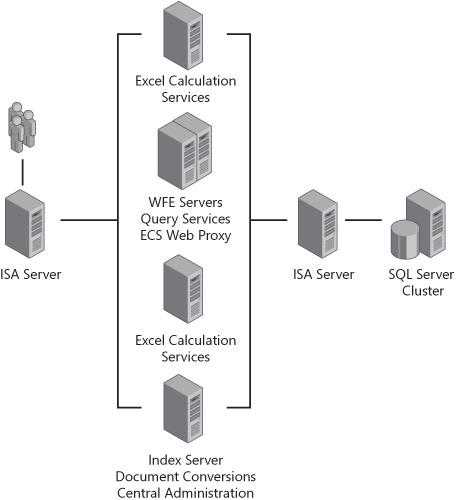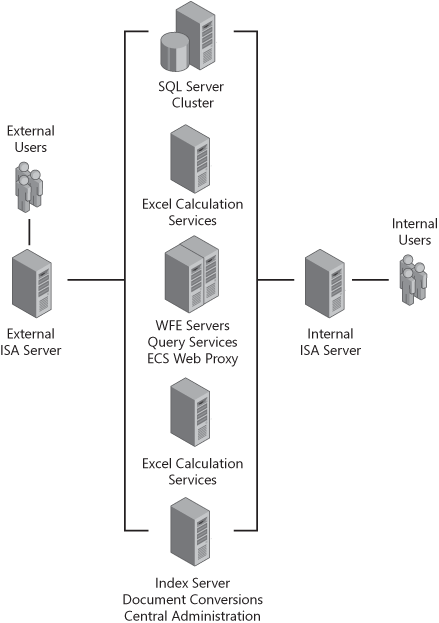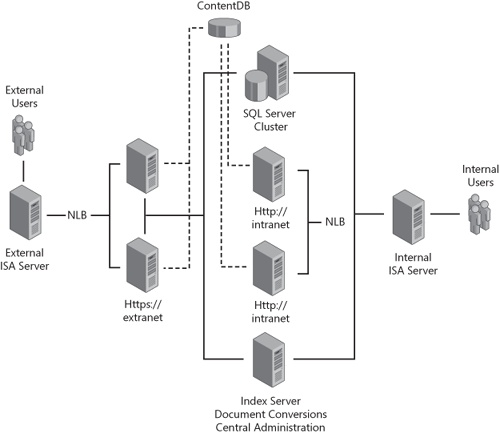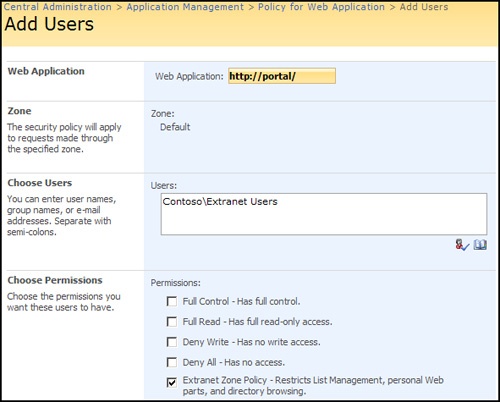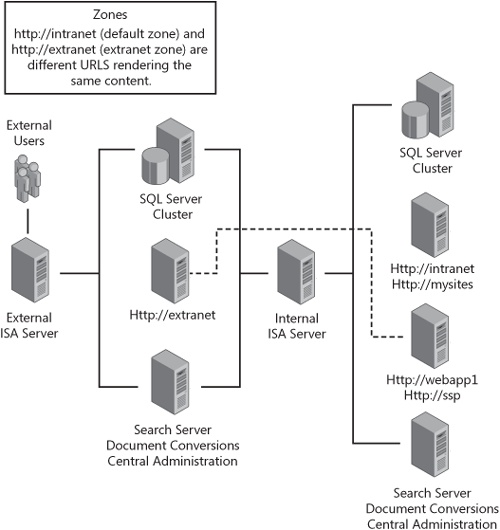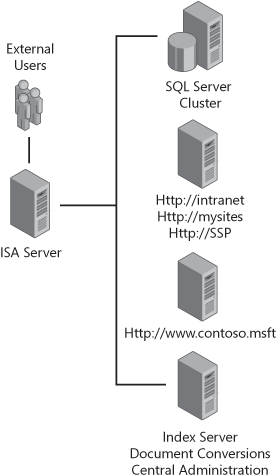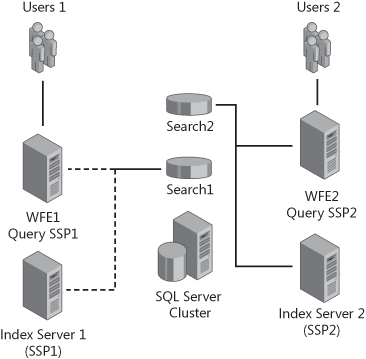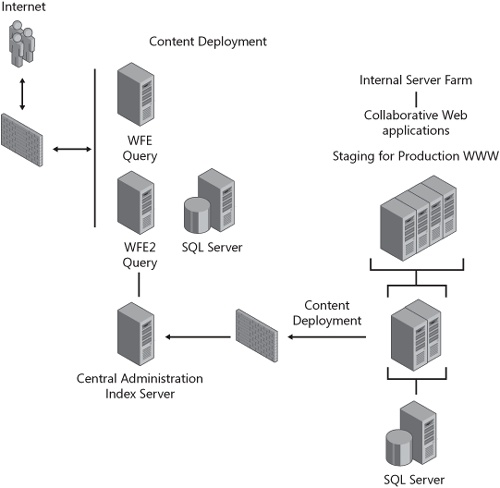Building farm topologies really isn’t an exact science, whether they are intranet solutions, extranet solutions, Internet solutions, or some combination thereof. It greatly depends on the infrastructure you already have in place. It depends on your firewalls, routers, switches, Active Directory, SQL Server, and—to be honest—the technical ability of the staff that manages each of those. It also depends on your organization’s culture and politics, as well as governmental regulations such as the National Institute of Standards and Technology (NIST), Sarbanes-Oxley (SOX), and Health Insurance Portability and Accountability Act (HIPAA).
The following section will present to you seven possible scenarios for SharePoint Server 2007 farm configurations:
These scenarios do not represent all possible variations, the inclusion of which would be lengthy and dilute the information specific to SharePoint Server 2007. As you read through the scenarios, you will quickly notice the driving factor behind most designs is securing the content. But what is insecure for one organization might prohibit another from staying in business. In our opinion, a security policy that puts your company out of business is a bad policy. You have to account for all of your implementation-specific requirements and balance the security of your farm. Keep in mind that security and usability are inversely proportional. We have never seen a secured—and we mean truly secured—environment that was very user friendly. What you can expect to find in the following sections are the most common successful scenarios and a few questionable scenarios.
This is arguably the simplest farm topology to install. Installing an intranet farm is essentially like installing a file server into your network. We believe an intranet SharePoint Server 2007 installation is a good place to begin. Building a SharePoint Server 2007 server farm that is available only to the internal, private network allows you to focus on the core of the technology rather than securing it from the outside world. But be forewarned: If you need to expose and share this installation later, you will most likely be moving some, if not all, of the farm into another subnet for security. The following scenarios are possible ways you can provide this functionality, each having its own advantages and tradeoffs.
If you were to build a SharePoint Server 2007 server farm that in no way was connected to the Internet, it would be very secure. Sure, there could be compromises by people who have physical access or access via modems, but that wouldn’t be an issue fixed by a specific farm topology. What if you build a farm that is accessible only on your private, internal network protected by a firewall? Isn’t that the same? Don’t get a false sense of security because you have a firewall. A private network is only as secure as its weakest link. If you had another service on this private network that was compromised, your SharePoint Server 2007 installation would be at risk. Therefore, we are assuming that you have adequately secured your private network and did not create firewall rules to the Internet for SharePoint Server 2007. It should be reasonably secured.
The first step in allowing remote access to SharePoint Server 2007 would be to set up a VPN client. Because the only remote access to the servers would be via corporate VPN, this is considered a secure solution by even the most skeptical information technology security professionals. Figure 20-8 shows a private server farm and three ways of securely accessing the content therein.
Figure 20-8 also shows the example of using dial-up connections for secure access. This is quickly being replaced with VPN technology but is still a viable remote solution when security is paramount.
Note
VPNs have matured and can now be leveraged without thick clients, but that discussion is beyond the scope of this book. You should include your information technology security team in the entire farm design, but especially when determining remote access.
The upside to a private network implementation is that you can rest assured that your valuable content is safe. The tradeoff is loss of functionality. Because SharePoint Server 2007 is often an organization’s core for collaboration, a private network limits the accessibility of collaborative information. If you need a more robust intranet sharing topology, you should consider allowing external access over SSL.
A split-farm topology places a firewall between members of the farm to include the SQL server. This gets into an advanced implementation because a number of factors affect the functionality of the farm. The primary reason for splitting the farm into different subnets is to secure the SQL server. Figure 20-9 is a logical representation of a common farm topology when splitting subnets.
The practice of placing the SQL server behind the primary firewall is to protect it from threats, such as the Slammer Worm. In reality, we often see it placed behind the primary firewall because less attention is spent securing the perimeter firewall than the internal firewall. Yes, both firewalls should be secured to the same level, but the real-world fact is that they are not. Placing the SQL server in a more secure subnet isn’t a perfect solution, however. If a hacker were to obtain access to your SharePoint Server 2007 farm from the Internet, he is now a short hop away from gaining access to your entire private network. We believe the best practice is to place the entire farm in the screened subnet.
Another common approach is to place an application server behind the primary firewall, thus securing your indexing functions and, more importantly, Central Administration. This does provide benefits, such as securing Web applications (e.g., the Records Center and Central Administration) and negating the need for indexing firewall rules (don’t forget, the indexer still needs to be able to connect to content sources!). But you may actually be opening up more vulnerability to your network than if you left the application server in the screened subnet. The risk may not be worth the extra security provided because NetBIOS traffic, or possibly server message block (SMB), still exists in most farm topologies. A prime example of this is query propagation. As can be seen in Figure 20-9, the WFE servers are also hosting the query role. Indexes are propagated continuously via file shares on the WFE servers. So, if you put the application server (hosting the index role) behind the primary firewall, you must now open firewall ports to allow file share access. This is generally bad practice, and most security professionals would advise strongly against it. For this reason, we think only the SQL server should be split from the farm if needed; in most cases, all members of the farm should be in the same subnet.
If you have a technically talented security team and you thoroughly understand firewall rules, auditing, and SharePoint Server 2007, you could most certainly implement your farm in a more advanced topology. Just remember to keep your installation as simple as possible while still meeting your technical requirements. The more barriers you raise between farm member servers, the more you will struggle with administrating that farm.
Another possibility for those who need Internet access to their intranet Web applications is to place the entire farm in the screened subnet. This simplifies the external access to your SharePoint Server 2007 server farm, but it does come at a price. First, you will need a SQL server dedicated to your screened subnet, if not to your SharePoint Server 2007 server farm. Many installations leverage an existing SQL server instance internally. There is the additional cost of hardware and software for that SQL server instance. Second, SharePoint Server 2007 is often used to connect to valuable corporate information that is stored in back-end systems, such as enterprise resource planning (ERP) or enterprise resource management (ERM) systems. If the entire farm is in the screened subnet, you will most likely need to create holes in the primary firewall to allow this access. A screened subnet intranet farm is shown in Figure 20-10.
The bottom line to implementing collaborative Web applications with Internet access is that, eventually, data must traverse between the private network and the Internet. It is both good and bad. The Internet provides a medium to easily collaborate, but it also provides a medium that offers others access to that data. Your goal should be designing, implementing, and testing an intranet environment that takes the most secure route. Only you can know the route for you through research and testing.
Extranets are basically intranets that allow external third parties access to information and therefore are generally considered less secure. Common third-party users are partners, vendors, and contractors. We will refer to these third-party users as semi-trusted users. Any time you share data with semi-trusted or untrusted users, you increase the risk of data compromise. Many times this content isn’t intentionally compromised, so keep that in mind.
Note
An organization’s intranet which permits members of the organization to access the intranet via the Internet via port 80 or 443 is normally also considered an extranet.
We are frequently asked by executives and administrators to show them how to share sensitive corporate information to others—risk free. Unfortunately, you cannot share information without the risk of it being passed to an unwanted party. Building an extranet or not building an extranet won’t make this problem go away. Dumpster diving—the practice of going through a business’s garbage looking for information—happens frequently. Employees sometimes print company information and dispose of it in public waste receptacles. So while sharing information on the Internet via an extranet might increase the electronic transfer risk, it sometimes lowers the risk of other data compromise threats by reducing content that is in printed form. When we build extranets for the purpose of sharing information, we try to build them in the most secure manner possible.
First, no matter what type of farm topology you choose, you will probably want to separate your extranet users from your intranet users. There are several ways to do this, and you must decide the best way. Here are a few ideas to get you started:
Organizational unit in Active Directory
Second Active Directory
Third-party LDAP
ASP.NET SQL database
Your extranet security will only be as good as the training and expertise that you and the other administrators have. As this discussion progresses into more complex farm configurations, leveraging zones and policies, "getting it right" becomes critical.
We don’t think zones give you absolute isolation, but they do provide a reasonable amount of protection from intentional data compromise. Most extranets are a good place for zones and policies. Because most of your extranet users are basically trusted users, the level of security can probably be less than if users were not trusted. Essentially, you are designing a "best effort" Web-sharing platform when you leverage zones.
So what does a zone-leveraged farm topology look like? It will most likely have a single collaborative Web application that is accessed by one or more URLs. In addition, each of these URLs may be rendered by different servers, as seen in Figure 20-11.
Using multiple URLs will complicate things, there’s no doubt about it. Remember that, in the Web application best practices section of this chapter, we discussed that all alerts are sent on the default zone. By default, this zone is the first URL created for a Web application. In a zone-leveraged farm topology, you want to carefully design around this fact. The best practice is usually to create the most secure zone as the default zone. This allows the embedded URL in e-mails to be accessible by anyone from anywhere on the Internet. A common mistake is creating the default URL as the internal address. That usually is not accessible from the Internet, so embedded alert URLs for remote users will fail. The most secure zone in an extranet topology should probably be an SSL-enabled application and also the default internal URL.
Note
Do not try to graphically show the logical Web application architecture and your physical farm architecture on the same diagram. This is very confusing and almost impossible to do. Remember that every server in the farm can host every Web application by default. Therefore, any server in the farm is capable of serving your entire logical architecture.
Recall that zone names have nothing to do with security by themselves; they are simply a naming convention for you. The advantages to using multiple extended and mapped Web applications, leveraging zones, is that you can apply security polices to a set of users for a given URL. This allows you to create and define policies for a URL. In this scenario, it is common to deny Manage Lists And Browse Folders for extranet users. This is thoroughly documented on TechNet, but you can see an example of the Central Administration setting in Figure 20-12.
Part of your solution’s overall design will be determining the minimum set of rights for extranet users. We usually err on the side of being too restrictive and then loosen permissions as needed and approved. You probably won’t apply any policies to your trusted users because they already have full access on another URL. We have seen customers, with mixed success, apply more restrictive policies for their trusted users, but only on the external URL. For those customers, it provided a way to restrict and scope the management of SharePoint Server 2007 to users while they are only on the intranet LAN.
If security is paramount in your extranet design, you will probably want to create a server farm, including a dedicated SQL server instance and Active Directory, that is dedicated to your extranet. This design simplifies the creation of the farm, but often complicates the connections to other systems. Extranets almost always need connections to internal systems for reasons such as accounting or inventory, and they create more issues in the firewall connections and authentication to those sources. Carefully think through the following when you design your extranet solution:
Who will need access to the system?
From where will they access it?
How will they access it?
What content needs to be shared?
Who will manage the content?
Who will manage the access?
One definite advantage to a physically isolated extranet solution is a single URL on a single zone. You can still leverage Web application policies to restrict extranet users. You can also mix the scenarios and split the extranet farm topology and leverage zones. Be warned: The complexity of your design increases dramatically when you do this. For example, extending your portal to the extranet via a different URL seems like a good idea, but how will users now get to their My Sites? Carefully plan and test any design that leverages both zones and physical isolation. Figure 20-13 shows an example of an extranet server farm consuming shared services from the internal provider. You would need to open external access to http://mysites or render it on the external server for full My Site functionality to external users.
The final two scenarios we present concern the use of SharePoint Server 2007 for your Internet-facing Web site, most commonly your WWW site. To review the best practices for building Internet-facing SharePoint Server 2007 sites, refer to Chapter 13. This section simply covers the farm topology and Web application configuration for those sites. There are two basic choices when building WWW applications on SharePoint Server 2007: sharing an existing farm or building a new, dedicated farm.
We find that a wrong example often instructs better than a good example. Therefore, we will begin with a wrong way to do Internet sites. Many organizations that are under budget constraints or simply lack the resources to build a second farm consider putting their WWW site into their collaborative farm. We can affirm that this is almost always a really bad idea. Figure 20-14 shows an example of what this would look like.
This solution is appealing because many administrators plan to use a split-farm topology to secure their WWW traffic from their collaborative traffic. Figure 20-14 shows a split-farm topology. So what’s the problem? First, you would need to create another SSP to host services consumed by your WWW site, such as search. This seems simple enough and would provide modest content isolation if you ignore this cautionary scenario. But both your intranet and WWW Web applications must share a common configuration database, even if they have their own content databases and associated SSPs. Second, you should remember that all servers in the farm serve all Web applications. To isolate traffic, you should direct users to the correct box via DNS and disable the unneeded IIS applications on the appropriate server. Third, there is no method to granularly define Search and Excel Calculation Services server roles within a farm. Yes, you can define which servers perform these roles, but you cannot limit the use of these services for a specific service. Figure 20-15 shows a graphical representation of this limitation with search. Once again, Figure 20-15 shows you what cannot be done in a farm topology.
Using Figure 20-15 as an example, both WFE1 and WFE2 would have a complete index copy and service queries for SSP1 and SSP1 Indexers. Because of this topology limitation, and the fact all Web applications must share a configuration database, you should not use the same server farm for intranet and WWW Web applications. A better design, when resources are an issue, is to use your private, collaborative server farm to develop content and deploy to a dedicated SharePoint Server 2007 server farm for WWW consumption.
The best practice of developing code on a Dev system, testing it on a Test system, and deploying it to a Production system should be followed when possible. This section refers to an internal farm, and that farm can be your collaborative farm or a dedicated Test farm. The latter is preferable, but we do not know your resource limitations or organizational culture.
Most Dev systems for SharePoint Server 2007 are virtual machines that can be easily deleted and rebuilt, but you need to test that code and preview any content before deployment. To accomplish this, you will need a test SharePoint Server 2007 server farm. As was previously mentioned, you do not want to use your internal farm for WWW traffic. Therefore, you must create a new server farm, which will probably reside in your screened subnet. Leveraging the Publishing Infrastructure, many companies simply edit content in-place while using development systems for custom code. This reduces the involvement of information technology for custom WWW content. But many organizations require private viewing of WWW content by managers, executives, and their legal department before deployment on the Internet-facing Web site. We recommend content deployment from one of your internal server farms to your external, dedicated WWW server farm. Figure 20-16 shows an example of two distinct server farms with content deployment between them.
Because it is a one-way connection during content deployment, the security risk of transferring content is very low. Be aware that this mechanism of content deployment is meant for Web content and not customizations such as Web parts, workflows, and policies. In fact, it should probably be used only for pages and images. But pages and images constitute the majority of updates on most WWW servers, so this method of content deployment is still a very viable solution for most companies.
More Info
See Chapter 13 for more information on content deployment.


